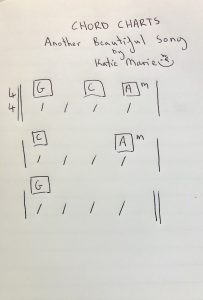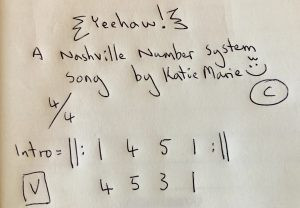Effective communication is paramount in any studio recording session, and for guitarists and songwriters, clear and concise Guitar Chord Charts are indispensable tools. Walking into a recording studio with well-prepared charts ensures that everyone is on the same page, saving valuable time and maximizing creative energy. Over my years of experience navigating diverse recording environments, I’ve witnessed firsthand the spectrum of chart preparation, from meticulously detailed scores to bare-bones MP3s. Regardless of the genre or complexity of the music, a session invariably benefits from accurate and readily understandable charts. Investing time in creating high-quality guitar chord charts beforehand translates to a smoother, more productive recording process, allowing musicians to focus on what truly matters: making great music. This guide will walk you through creating effective guitar chord charts for any studio session.
Laying the Foundation: Song Structure
Before diving into different charting methods, establishing the song structure is crucial. Think of it as the blueprint of your song, providing a roadmap for everyone involved. Using standard abbreviations is a common and efficient way to outline this structure in your guitar chord chart:
- V: Verse
- C or CH: Chorus
- B or BD: Bridge
- Pre-C: Pre-Chorus
- Outro: Outro
- Intro: Introduction
- Inst: Instrumental
For musicians familiar with UK terminology, the Bridge is often referred to as a “Middle 8,” abbreviated as “M8” in charts. While some purists might differentiate between a Bridge and a Middle 8, in practical studio settings, especially with UK musicians, “Middle 8” generally indicates the bridge section. Clearly defining your song structure with these abbreviations at the top of your guitar chord chart provides immediate clarity and context for all musicians.
Exploring Different Types of Guitar Chord Charts
Once the structural framework is in place, you can choose the type of guitar chord chart that best suits your needs and the complexity of the music. While these examples are geared towards melodic instruments, they can be adapted for drums and percussion, although detailed drum charts are often preferred for nuanced rhythmic information.
1. Lyrics with Guitar Chords
 Guitar chord chart example with lyrics and chords above the words
Guitar chord chart example with lyrics and chords above the words
Alt text: Simple guitar chord chart example displaying song lyrics with chord names written above the corresponding words.
For beginners or songs with straightforward chord progressions, lyrics with chords are an incredibly accessible option for guitar chord charts. This format is easy to read and follow, as the chord names are written directly above the lyrical phrases where the chord changes occur. Many guitarists find this method intuitive and quick to grasp, making it excellent for initial rehearsals or sessions where speed and simplicity are prioritized. However, the limitation of this type of guitar chord chart is its lack of rhythmic precision. It doesn’t visually represent how chords align within the bars, which can be crucial for more rhythmically intricate parts or complex musical arrangements. Despite this, lyrics with chords serve as a fantastic starting point for creating guitar chord charts, especially when musical theory familiarity is limited, or for quickly conveying the basic harmonic structure of a song.
2. Standard Guitar Chord Charts with Rhythm Markings
 Example of a standard guitar chord chart with rhythm markings and time signature
Example of a standard guitar chord chart with rhythm markings and time signature
Alt text: Standard guitar chord chart example showing 4/4 time signature and rhythm markings below chords to indicate beat duration.
Moving a step further in detail, standard guitar chord charts incorporate rhythm markings to provide a clearer picture of chord durations within each bar. Typically presented in 4/4 time signature as shown in the example, these charts use lines or other visual cues beneath the chord names to indicate the number of beats each chord should be sustained. In the example provided, under the first bar, you can see rhythm markings indicating that the G chord receives two beats, C gets one beat, and Am also gets one beat. This method accurately portrays the rhythmic feel of the music, crucial for musicians to interpret the groove and timing correctly. Another common approach to rhythm marking is aligning the first chord of a bar with the first beat, visually representing the start of each measure. For instance, in a variation of the previous example, both the G and C chords could be marked to receive two beats each within a 4/4 bar. These standard guitar chord charts offer a balance between simplicity and rhythmic accuracy, making them widely used in studio sessions for songs with moderate rhythmic complexity, and are particularly helpful for guitarists needing precise timing information at a glance.
3. Nashville Number System for Guitar Chord Charts
 Nashville Number System chart example showing numbers instead of chord names
Nashville Number System chart example showing numbers instead of chord names
Alt text: Guitar chord chart example using the Nashville Number System, displaying numbers to represent chords for key flexibility.
The Nashville Number System offers an elegant and adaptable method for charting songs, particularly beneficial in songwriting and arranging stages where key changes are frequent. Its brilliance lies in its simplicity and key-agnostic nature. Instead of using chord names like G or C, this system employs numbers to represent chords based on their position within a musical key.
How it Works for Guitarists:
In a Major Key:
- 1 = Major
- 2 = Minor
- 3 = Minor
- 4 = Major
- 5 = Major
- 6 = Minor
- 7 = Diminished
In a Minor Key:
- 1 = Minor
- 2 = Diminished
- 3 = Major
- 4 = Minor
- 5 = Minor
- 6 = Major
- 7 = Major
Consider a song in C major. The C major scale notes are C, D, E, F, G, A, B. Using the number system, a 2-bar verse in C major might be charted as:
[ 1 1 4 5 ] [ 1 1 2 2 ]
This translates to the chord progression: C C F G | C C Dm Dm.
The real power emerges when transposing keys. If you decide to shift the song to G major, the same number chart remains valid:
[ 1 1 4 5 ] [ 1 1 2 2 ]
Now, applying the G major scale and the number system, this becomes: G G C D | G G Am Am.
For guitarists, the Nashville Number System simplifies on-the-fly key changes and is invaluable for collaborative songwriting and studio sessions where arrangements are still evolving. The system also utilizes symbols for rhythmic nuances; for instance, a diamond around a number indicates a sustained chord, and a ^ symbol signifies a staccato or cut-off chord. While traditional notation can also be integrated for rhythmic detail, experimenting with the Nashville Number System’s symbology can streamline your guitar chord charts. Exploring resources dedicated to the Nashville Number System will further unlock its potential for guitarists in various musical scenarios.
4. Full Musical Score for Guitar
Creating a full musical score represents the most comprehensive approach to charting music. This method encompasses every detail, including melody lines, precise rhythms, harmonies, and articulations. If ultimate precision and control are required, a full score leaves no room for ambiguity. For guitarists working in genres that demand intricate arrangements or when collaborating with musicians from diverse musical backgrounds, full scores can be exceptionally useful. However, it’s important to acknowledge that outside of classical music circles, many contemporary musicians may not be fluent in reading full music notation. Despite this, professional session musicians are often adept at navigating scores, and a full score remains the gold standard for conveying every musical nuance note-for-note. For complex guitar parts, fingerstyle arrangements, or when working with classically trained musicians, providing a full score as your guitar chord chart ensures everyone has access to the most granular level of musical information.
Final Thoughts on Guitar Chord Charts
Mastering the art of creating effective guitar chord charts is a skill that significantly enhances your professionalism and efficiency in recording sessions. Whether you opt for the simplicity of lyrics with chords, the rhythmic clarity of standard charts, the flexibility of the Nashville Number System, or the detail of a full score, the key is to choose the method that best communicates your musical ideas to fellow musicians. Experiment with these different types of guitar chord charts to discover what works best for your style and the demands of your projects. Clear, accurate charts are a sign of professionalism and contribute directly to a smoother, more creative, and ultimately more successful recording experience for everyone involved.
